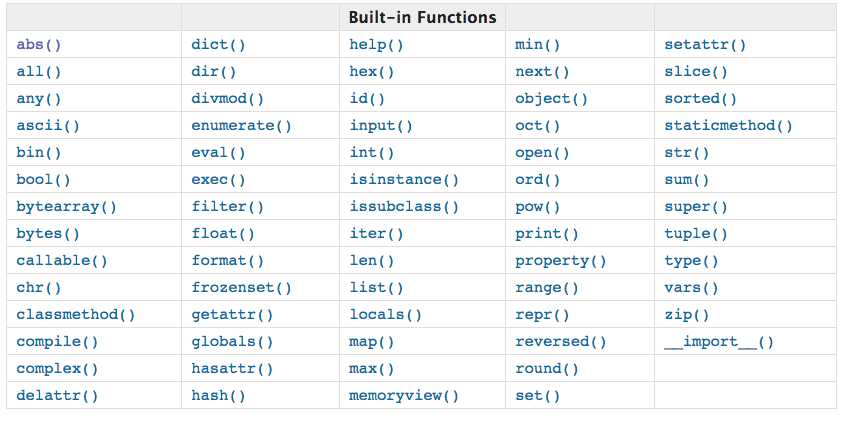内置函数
Posted bianfengjie
tags:
篇首语:本文由小常识网(cha138.com)小编为大家整理,主要介绍了内置函数相关的知识,希望对你有一定的参考价值。
一、常见内置函数

https://docs.python.org/3/library/functions.html
二、计算类
1、abs(x)
取绝对值
>>> abs(-10) 10
2、all(iterable)
如果这个可迭代的元素都为真,则返回真(非0的就为真,负数也是为真)
>>> all([2,3,1,0]) False >>> all([2,3,1]) True >>> all([2,3,-1]) True
3、any(iterable)
可迭代的元素中,有一个为真,则返回真,空列表返回假。
>>> any([]) False >>> any([0]) False >>> any([2,4]) True
4、bool([x])
功能:返回一个布尔值,空列表为假,不为空为真
>>> bool([]) False >>> bool([6,7]) True
5、divmod(a,b)
功能:地板除,获得一个元组,元组第一个元素是商,第二个元素是余数。
>>> divmod(4,3) (1, 1) >>> divmod(5,3) (1, 2) #1是商,2是余数
三、数据类型转换类
1、ascii(object)
把内存对象变成一个可打印的字符串格式
>>> ascii([1,2,34,4]) ‘[1, 2, 34, 4]‘
2、bin(x)
把一个整数转换成二进制
>>> bin(80) ‘0b1010000‘
3、bytes([source[, encoding[, errors]]])
把字符串转换成字节
>>> a = bytes("mnop",encoding="utf-8")
>>> a
b‘mnop‘
>>> a[0]
109
>>> a[0]=w
Traceback (most recent call last):
File "<stdin>", line 1, in <module>
NameError: name ‘w‘ is not defined
注:(1)可以访问到字符对应的ASCII值
(2)bytes声明的字符串不可以修改里面的值
4、bytearray[source[, encoding[, errors]]]
功能:字节数组,并且可以修改二进制的字节
>>> b = bytearray("abcd",encoding="utf-8")
>>> b
bytearray(b‘abcd‘)
>>> b[1]
98
>>> b[1]=100
>>> b[1]
100
5、dict(**kwarg)、dict(mapping, **kwarg)、dict(iterable, **kwarg)
功能:返回一个字典
>>> dict()
{}
>>> dict(name=‘bianbian‘,age=18,love=‘pengpeng‘)
{‘name‘: ‘bianbian‘, ‘age‘: 18, ‘love‘: ‘pengpeng‘}
>>> dict([(‘name‘,‘bianbian‘),(‘age‘,18),(‘love‘,‘pengpeng‘)])
{‘name‘: ‘bianbian‘, ‘age‘: 18, ‘love‘: ‘pengpeng‘}
>>> dict([[‘name‘,‘bianbian‘],[‘age‘,18],[‘love‘,‘pengpeng‘]])
{‘name‘: ‘bianbian‘, ‘age‘: 18, ‘love‘: ‘pengpeng‘}
6、exec(object[, globals[, locals]])
功能:有语句的和复杂的语句的字符串转换成表达式???
code = ‘‘‘def timmer(func): #timmer(test) func=test
def fex(*args,**kwargs):#传入非固定参数
res=func(*args,**kwargs) #传入非固定参数
return res
return fex
#不带参数
@timmer
def test1(): # 相当于test1 = timmer(test1)
print("in the test1")
return "from the test1" # 执行函数test1有返回值
res = test1()
print(res)
‘‘‘
exec(code)
#结果
in the test1
from the test1
7、filter(function, iterable)
功能:通过function过滤条件,去获取iterable中你想要的数据。
四、判断类
1、callable(object)
功能:判断一个对象是否可以被调用,只有在后面有括号的,表示可以调用,比如:函数,类。
>>> callable([]) False >>> def test():pass ... >>> callable(test) True
2、chr(i)
功能:通过ascii的值,找到对应的字符
>>> b = bytearray("abcd",encoding="utf-8")
>>> b
bytearray(b‘abcd‘)
>>> b[1]=100
>>> b[1]
100
>>> chr(100)
‘d‘
3、ord(c)
功能:根据字符,找到对应的ascii值
>>> b = bytearray("abcd",encoding="utf-8")
>>> b
bytearray(b‘abcd‘)
>>> b[1]=100
>>> ord(‘d‘)
100
4、dir([object])
功能:看一个对象有哪些方法
>>> name=[] >>> dir(name) [‘__add__‘, ‘__class__‘, ‘__contains__‘, ‘__delattr__‘, ‘__delitem__‘, ‘__dir__‘, ‘__doc__‘, ‘__eq__‘, ‘__format__‘, ‘__ge__‘, ‘__getattribute__‘, ‘__getitem__‘, ‘__gt__‘, ‘__hash__‘, ‘__iadd__‘, ‘__imul__‘, ‘__init__‘, ‘__init_subclass__‘, ‘__iter__‘, ‘__le__‘, ‘__len__‘, ‘__lt__‘, ‘__mul__‘, ‘__ne__‘, ‘__new__‘, ‘__reduce__‘, ‘__reduce_ex__‘, ‘__repr__‘, ‘__reversed__‘, ‘__rmul__‘, ‘__setattr__‘, ‘__setitem__‘, ‘__sizeof__‘, ‘__str__‘, ‘__subclasshook__‘, ‘append‘, ‘clear‘, ‘copy‘, ‘count‘, ‘extend‘, ‘index‘, ‘insert‘, ‘pop‘, ‘remove‘, ‘reverse‘, ‘sort‘]
5、enumerate(iterable,start=0)
功能:遍历一个可迭代对象,获取索引和对应的元素的值
>>> a=[‘a‘,‘b‘,‘c‘,‘d‘] >>> list(enumerate(a)) [(0, ‘a‘), (1, ‘b‘), (2, ‘c‘), (3, ‘d‘)] >>> list(enumerate(a,start=2)) [(2, ‘a‘), (3, ‘b‘), (4, ‘c‘), (5, ‘d‘)]
以上是关于内置函数的主要内容,如果未能解决你的问题,请参考以下文章